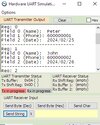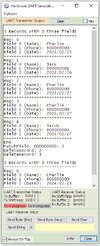DogFlu66
Member
Note: The final library can be downloaded in response 20 of this thread.
Hello; I have been converting an old door opener program by telephone touch (phone call) to this language.
Not having a function in the language that allows me to associate data, I have written a library to simulate the use of registers and fields.
I thought it would be very complex to do, but it is actually very simple and is done with a couple of very simple functions and with hardly any code in them.
I leave the example for those who want to play with them for a while in the environment simulator:
'***********************************************************************
'Experimental functions for simulate registers with fields.
'Pic18F26k22, OshonSoft Pic18 Basic Compiler v5.33
'By COS, 2024/02/24
'***********************************************************************
'Phone list:
'Fields: Name, Phone and Date.
'Length of fields equal to 10 characters.
'***********************************************************************
#define CLOCK_FREQUENCY = 64 'Clock 64Mhz
#define STRING_MAX_LENGTH = 12
'#define SIMULATION_WAITMS_VALUE = 1
'***********************************************************************
'***********************************************************************
main:
UART1_Init 115200
'UART2_Init 4800
'WaitMs 1
Dim _String[10] As String 'Auxiliary variable for data exchange.
Dim x As Byte
'Initializes the list vector.
Call _Pointer0(P_List)
Format_List(P_List)
'Write field (write registers)
Write_List("Peter", Name, 0, P_List) 'Reg (0,0)
Write_List("600000001", Phone, 0, P_List) 'Reg (0,1)
Write_List("2024/02/25", Date, 0, P_List) 'Reg (0,2)
Write_List("John", Name, 1, P_List) 'Reg (1,0)
Write_List("600000002", Phone, 1, P_List) 'Reg (1,1)
Write_List("2024/02/26", Date, 1, P_List) 'Reg (1,2)
Write_List("George", Name, 2, P_List) 'Reg (2,0)
Write_List("600000003", Phone, 2, P_List) 'Reg (2,1)
Write_List("2024/02/27", Date, 2, P_List) 'Reg (2,2)
UART_Write "Registers with three fields", CrLf
UART_Write "---------------------------", CrLf, CrLf
'Extract field (read registers).
For x = 0 To 9 'Registers
UART_Write "Reg: ",#x, CrLf
_String = Read_List(Name, x, P_List)
UART_Write "Field 0 (Name): ", _String, CrLf
_String = Read_List(Phone, x, P_List)
UART_Write "Field 1 (Phone): ", _String, CrLf
_String = Read_List(Date, x, P_List)
UART_Write "Field 2 (Date): ", _String, CrLf
UART_Write "---------------------------", CrLf
Next x
UART_Write "End", CrLf
End
'From here, export the code as a library.
'*************************************************************************
'* Functions To simplify working with lists or small database simulation *
'* By COS, 20240225, OshonSoft Pic18 v5.33 *
'*************************************************************************
'*****************************************************************************************
'For two fields per register.
'*****************************************************************************************
'Declares the elements necessary to form the list [Name, Phone].
//Const nFields = 2 'Number of fields per register.
//Const FieldLength = 10 'Field length
//Const nRegisters = 20 'Number of registers = nReg * nField
//Dim List(200) As Byte 'Vector length equals nReg * FieldLength
'Dim _String[10] As String 'Auxiliary variable for data exchange.
//Const Name = 0 'To select the Name field.
//Const Phone = 1 'To select the Phone field.
'*****************************************************************************************
'*****************************************************************************************
'For three fields per register.
'*****************************************************************************************
'Declares the elements necessary to form the list [Name, Phone, Date].
Const nFields = 3 'Number of fields per register.
Const FieldLength = 10 'Field length
Const nRegisters = 30 'Number of registers = nReg * nField
Dim List(300) As Byte 'Vector length equals nReg * FieldLength
'Dim _String[10] As String 'Auxiliary variable for data exchange.
Const Name = 0 'To select the Name field.
Const Phone = 1 'To select the Phone field.
Const Date = 2 'To select the Date field.
'*****************************************************************************************
'Pointer
Dim P_List As Word 'It will contain the address of then firs element of the list vector.
Symbol _p0 = List 'Indicates the vector to use as a list.
'******************************************************************************************************
'In the Main: to initialize the list.
'Call _Pointer0(P_List) 'Call from main to assign the address of the vector before using the functions.
'Format_List(P_List) 'Call function to start the list once you know the address.
'******************************************************************************************************
'Pointer assignment for Pic18 series.
Proc _Pointer0(ByRef _p As Word)
Symbol _Return_HB = _p.HB
Symbol _Return_LB = _p.LB
ASM: LFSR 2, _p0
ASM: MOVFW FSR2H
ASM: MOVWF _Return_HB
ASM: MOVFW FSR2L
ASM: MOVWF _Return_LB
End Proc
'*************************************************
'Function to "Write" a field in a register
'*************************************************
'field: field on which work will be done.
'register: register on which work will be done.
'string_input: field to add to the list.
'p_array = Address of the first element of the list vector.
'Writes a copy of the input string to the requested field of the indicated register.
Function Write_List(string_input[10] As String, field As Word, register As Word, p_array As Word) As Word
Dim index As Word
Dim flag As Bit
flag = 0
'Calculates the address of the first element of the field.
p_array = field + (register * (FieldLength * nFields)) + (field * (FieldLength -1)) + p_array
For index = 0 To (FieldLength -1) 'Traverse the field using the index "x".
If string_input(x) = 0 Then flag = 1 'End of field mark
If flag = 0 Then
Pointer(index + p_array) = string_input(index) 'Write a copy in the indicated register field.
Else
Pointer(index + p_array) = 0 'Remove any unused characters from the field.
Endif
Next index
End Function
'*************************************************
'Function to "Read" a field in a register
'*************************************************
'field = field on which work will be done.
'register = register on which work will be done.
'p_array = Address of the first element of the list vector.
'The requested field is returned according to the input parameters.
Function Read_List(field As Word, register As Word, p_array As Word) As String
Symbol Return_String = Read_List 'Returns requested field.
Dim index As Word
'Calculates the address of the first element of the field.
p_array = field + (register * (FieldLength * nFields)) + (field * (FieldLength -1)) + p_array
For index = 0 To (FieldLength -1) 'Traverse the field using the index.
Return_String(index) = Pointer(index + p_array) 'makes a copy of the requested field.
Next index
End Function

Hello; I have been converting an old door opener program by telephone touch (phone call) to this language.
Not having a function in the language that allows me to associate data, I have written a library to simulate the use of registers and fields.
I thought it would be very complex to do, but it is actually very simple and is done with a couple of very simple functions and with hardly any code in them.
I leave the example for those who want to play with them for a while in the environment simulator:
'***********************************************************************
'Experimental functions for simulate registers with fields.
'Pic18F26k22, OshonSoft Pic18 Basic Compiler v5.33
'By COS, 2024/02/24
'***********************************************************************
'Phone list:
'Fields: Name, Phone and Date.
'Length of fields equal to 10 characters.
'***********************************************************************
#define CLOCK_FREQUENCY = 64 'Clock 64Mhz
#define STRING_MAX_LENGTH = 12
'#define SIMULATION_WAITMS_VALUE = 1
'***********************************************************************
'***********************************************************************
main:
UART1_Init 115200
'UART2_Init 4800
'WaitMs 1
Dim _String[10] As String 'Auxiliary variable for data exchange.
Dim x As Byte
'Initializes the list vector.
Call _Pointer0(P_List)
Format_List(P_List)
'Write field (write registers)
Write_List("Peter", Name, 0, P_List) 'Reg (0,0)
Write_List("600000001", Phone, 0, P_List) 'Reg (0,1)
Write_List("2024/02/25", Date, 0, P_List) 'Reg (0,2)
Write_List("John", Name, 1, P_List) 'Reg (1,0)
Write_List("600000002", Phone, 1, P_List) 'Reg (1,1)
Write_List("2024/02/26", Date, 1, P_List) 'Reg (1,2)
Write_List("George", Name, 2, P_List) 'Reg (2,0)
Write_List("600000003", Phone, 2, P_List) 'Reg (2,1)
Write_List("2024/02/27", Date, 2, P_List) 'Reg (2,2)
UART_Write "Registers with three fields", CrLf
UART_Write "---------------------------", CrLf, CrLf
'Extract field (read registers).
For x = 0 To 9 'Registers
UART_Write "Reg: ",#x, CrLf
_String = Read_List(Name, x, P_List)
UART_Write "Field 0 (Name): ", _String, CrLf
_String = Read_List(Phone, x, P_List)
UART_Write "Field 1 (Phone): ", _String, CrLf
_String = Read_List(Date, x, P_List)
UART_Write "Field 2 (Date): ", _String, CrLf
UART_Write "---------------------------", CrLf
Next x
UART_Write "End", CrLf
End
'From here, export the code as a library.
'*************************************************************************
'* Functions To simplify working with lists or small database simulation *
'* By COS, 20240225, OshonSoft Pic18 v5.33 *
'*************************************************************************
'*****************************************************************************************
'For two fields per register.
'*****************************************************************************************
'Declares the elements necessary to form the list [Name, Phone].
//Const nFields = 2 'Number of fields per register.
//Const FieldLength = 10 'Field length
//Const nRegisters = 20 'Number of registers = nReg * nField
//Dim List(200) As Byte 'Vector length equals nReg * FieldLength
'Dim _String[10] As String 'Auxiliary variable for data exchange.
//Const Name = 0 'To select the Name field.
//Const Phone = 1 'To select the Phone field.
'*****************************************************************************************
'*****************************************************************************************
'For three fields per register.
'*****************************************************************************************
'Declares the elements necessary to form the list [Name, Phone, Date].
Const nFields = 3 'Number of fields per register.
Const FieldLength = 10 'Field length
Const nRegisters = 30 'Number of registers = nReg * nField
Dim List(300) As Byte 'Vector length equals nReg * FieldLength
'Dim _String[10] As String 'Auxiliary variable for data exchange.
Const Name = 0 'To select the Name field.
Const Phone = 1 'To select the Phone field.
Const Date = 2 'To select the Date field.
'*****************************************************************************************
'Pointer
Dim P_List As Word 'It will contain the address of then firs element of the list vector.
Symbol _p0 = List 'Indicates the vector to use as a list.
'******************************************************************************************************
'In the Main: to initialize the list.
'Call _Pointer0(P_List) 'Call from main to assign the address of the vector before using the functions.
'Format_List(P_List) 'Call function to start the list once you know the address.
'******************************************************************************************************
'Pointer assignment for Pic18 series.
Proc _Pointer0(ByRef _p As Word)
Symbol _Return_HB = _p.HB
Symbol _Return_LB = _p.LB
ASM: LFSR 2, _p0
ASM: MOVFW FSR2H
ASM: MOVWF _Return_HB
ASM: MOVFW FSR2L
ASM: MOVWF _Return_LB
End Proc
'*************************************************
'Function to "Write" a field in a register
'*************************************************
'field: field on which work will be done.
'register: register on which work will be done.
'string_input: field to add to the list.
'p_array = Address of the first element of the list vector.
'Writes a copy of the input string to the requested field of the indicated register.
Function Write_List(string_input[10] As String, field As Word, register As Word, p_array As Word) As Word
Dim index As Word
Dim flag As Bit
flag = 0
'Calculates the address of the first element of the field.
p_array = field + (register * (FieldLength * nFields)) + (field * (FieldLength -1)) + p_array
For index = 0 To (FieldLength -1) 'Traverse the field using the index "x".
If string_input(x) = 0 Then flag = 1 'End of field mark
If flag = 0 Then
Pointer(index + p_array) = string_input(index) 'Write a copy in the indicated register field.
Else
Pointer(index + p_array) = 0 'Remove any unused characters from the field.
Endif
Next index
End Function
'*************************************************
'Function to "Read" a field in a register
'*************************************************
'field = field on which work will be done.
'register = register on which work will be done.
'p_array = Address of the first element of the list vector.
'The requested field is returned according to the input parameters.
Function Read_List(field As Word, register As Word, p_array As Word) As String
Symbol Return_String = Read_List 'Returns requested field.
Dim index As Word
'Calculates the address of the first element of the field.
p_array = field + (register * (FieldLength * nFields)) + (field * (FieldLength -1)) + p_array
For index = 0 To (FieldLength -1) 'Traverse the field using the index.
Return_String(index) = Pointer(index + p_array) 'makes a copy of the requested field.
Next index
End Function
Attachments
Last edited:



